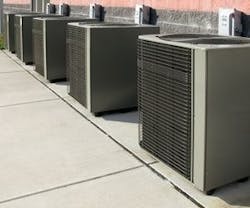Maintaining Your HVAC System
Maintaining your HVAC systems not only protects the equipment – it also protects the people in your building from discomfort and IAQ concerns, and protects you from a lawsuit. There are many ways to make sure that indoor air is kept at appropriate levels:
- Keep an eye on the air vents – you can find out if mold or other pollutants are entering your occupied space.
- Watch for a musty odor.
- Keep in touch with tenants/occupants, and ask them to participate in surveys regarding air quality.
- Listen to people’s complaints and take them seriously.
In addition to keeping IAQ in check, routine maintenance can also lower utility costs and reduce equipment-replacement costs. Check out these tips from a variety of sources about HVAC maintenance and preservation.
Replace Filters (every 1-6 months)
Filters should be replaced regularly. Inspect them routinely for a few months and then decide, based on what you see, how often they should be replaced.
Evaporator coils are a place that mold grows best. In addition to constant dampness, the supply side of the coil is in contact with outside air and the dirt that isn’t caught by filters.
The condenser coil degrades quickly because of dirt. It doesn’t have an effect on indoor air quality, so cleaning it at the same time you clean the evaporator coil will improve energy efficiency.
Coils soiled with microbial growth are hard to clean. A cleaning product with an appropriate dwell time is required to eliminate the micro-organisms. Built-up fungal growth is difficult to clean from metal surfaces, but don’t use an aggressive cleaner. Keeping the coils clean from the start will cut down on the time you spend on maintenance. Antimicrobial treatments are a good option to interrupt the growth of mold.
Inspect Fan, Bearings, and Belts (twice annually)
Even though fan, bearing, and belt operation don’t have a direct impact on IAQ, you should still inspect these pieces as part of your preventive-maintenance plan. Cleaning the blades on a small fan can take an hour or more; cleaning larger fans, especially those with multiple wheels on a single shaft, can take quite a while.
Check to see if fan motors are running in the wrong direction. This may not be obvious because fans can still supply flow if they’re running backwards. Clear labels on the fan housing, pulleys, the motor, and wires can prevent this problem.
Self-lubricating bearings on fans need the bearing cassette replaced when they fail. Look for lots of noise, vibration, or heat coming from the bearing. Greased ball bearings are occasionally found in packaged units; their most common problem is over-greasing, which can be as damaging as under-greasing.
Belts should be aligned to prevent wear. Maintain proper tension; loose belts slip on the pulley wheels, causing torque loss and rapid wear. Belts that are too tight put an extreme load on the motor and fan shaft bearings, causing premature failure.
Inspect Area Around Air Intake (twice annually)
Water can pool around air-handlers, and mold can grow there. Mold near the air intake means that spores could be sucked into the ventilation system and brought into your building. Check for standing water around the air-handler.
Fix Leaks in Cabinet and Supply Duct (annually)
Annual check-ups should contain a search for air leaks, a replacement of screws or latches, and patching or replacing gaskets. Cabinet and duct reliability is particularly important on the supply-air side, where high pressure can force air out of a small crack.
Clean and Adjust Dampers (annually)
Improper damper operation is one of the most common problems in HVAC equipment, and this can negatively affect indoor air quality and increase utility use.
Operating properly, dampers keep the compressor from running when the outside air temperature is lower than approximately 60 degrees F. If they’re not kept clean and lubricated, they stick, denying free cooling potential or overloading the cooling coil with too much hot outside air.
All movable surfaces should be cleaned and lubricated. Afterwards, a damper should be run through the full range. Then, you should check the setpoint.
Clean Air Ducts (every 2 years)
The National Air Duct Cleaners Association (NADCA) recommends inspecting supply side and return air ducts every 2 years (once per year in hospitals). If you find dirt, clean the ducts.
